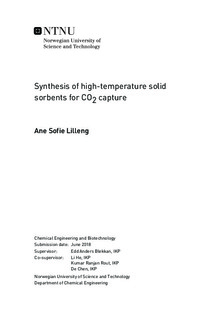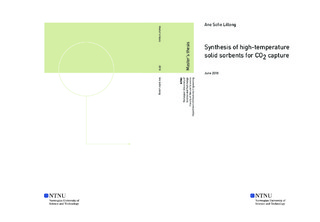| dc.description.abstract | The use of fossil fuels have escalated since the first industrial applications at the mid 19th century with a consequence of increased emissions of carbon dioxide and other green house gases. As a result, the global climate has been affected negatively and caused an elevated global average temperature. Because of this it is desirable to limit further emissions of green house gases, especially carbon dioxide which is the main contributor. Carbon Capture and Storage technology (CCS) is an interesting solution, but due to disadvantages of the present state of the art technology, high-temperature solid sorbents are investigated as a possible solution. Sorbents base don calcium oxide have gained attention since they have a high carbon dioxide capacity and the raw materials are cheap and abundant. The disadvantage of this technology is a steep decline in capacity during the initial carbonation-calcination cycles which is attributed to sintering. The goal of this work was to synthesize high-temperature solid sorbents based on calcium oxide for carbon dioxide capture by incorporation of dopants in calcined dolomite. The scope of this work was also to determine the optimal sorbent composition that gives the highest cyclic stability. The dopants form metal oxides upon heat treatment which acts as a structural stabilization among the calcium oxide particles.
This work have utilized dolomite as the source for calcium oxide for the synthesis. Dolomite, which is calcium magnesium carbonate, was calcined at 800 degrees celsius for 6 hours to make the calcium oxide source. Sorbents were prepared using a one-pot granulation procedure which consists of impregnation and granulation. Calcined dolomite was doped with the elements Mg, Zr, Al and Ce using incipient wetness impregnation. Mostly soluble precursors were used, but cement was also utilized as an Al-precursor since it is easier to handle and a cheaper alternative. Granulation was performed after impregnation, and the dried sorbents were sifted into four size ranges, below 250 um, 250 to 500 um, 500 to 850 um and above 850 um. The sorbents were pre-calcined at 800 degrees celsius for 3 hours in an inert atmosphere and at 950 degrees celsius for 3 hours in an atmosphere containing air. The sorbents with the size 500-850 um were tested under wet carbonation conditions in the TGA. Carbonation was run at 570 degrees celsius with 10 percent CO2 and 8 percent steam balanced with Ar. Calcination was run at 950 celsius with 100 percent CO2. The sorbents were characterised using nitrogen adsorption-desorption, mercury porosimetry, XRD, a mechanical falling test, SEM and EDS. Calcined dolomite was also characterised using the three former methods.
The impregnation of the dopants Mg, Zr, Al and Ce gave the stabilizing phases magnesium oxide, calcium zirconate, mayenite and cerium dioxide. The capturing capacity in the first cycle, C1, was comparable for most sorbents with a value around 30 percent, except the sorbents Al(insol)Mg and Al(insol)AZr which had an initial capacity of 23.3 percent and 36.1 percent, respectively. The specific surface area and pore volume of the sorbents were lower compared to calcined dolomite, and this was attributed to the pre-calcination procedure. The adsorption isotherms and the pore size distribution plots revealed that calcined dolomite and the sorbents had similar features in the mesoporous range, except for a higher volumetric appearance of pores in the raw material. The mercury intrusion experiment showed that the sorbents Al(insol)Ce and Al(insol)AZr had a lower volumetric appearance of macropores and a shift in maximum when compared to calcined dolomite. It was not observed any relations between C1 and specific surface area, nor C1 and pore volume. It was speculated that this was due to the relatively narrow range of values these parameters lay in.
The examination of the raw files from the TGA experiments showed that the captured carbon dioxide was released during the regeneration step. The deactivation of sorbents was therefore not because of permanent trapping of calcium carbonate in the pores, but rather sintering of calcium oxide particles. This result was supported by comparing SEM pictures of fresh and spent sorbents which revealed that carbonation-calcination cycling lead to larger particles and a more compact structure.
An elemental mapping was performed of the sorbents Al(sol)Mg and Al(sol)Mg to explore if the use of different Al-precursors lead to differences in distribution of aluminium. It was found that the distribution of aluminium using aluminium nitrate as precursor was slightly more even compared to utilization of cement as the precurosr. An elemental mapping of the least and most stable sorbents relative to cycle 14, Al(insol)AZr and MgZr, was also performed. The analysis showed that both sorbents had some areas which exhibited higher concentration of dopants within the analyzed area. Therefore it was speculated that the slighty inhomogeneously distribution of dopants was only one of the factors affecting cyclic stability.
The sorbents Al(sol)Ce, Al(insol)Mg and MgZr stood out since they had the highest stability from cycle 14 to 68. The relative loss in CO2 capacity from cycle 14 to 68 was 31.6 percent, 25.0 percent and 11.8 percent, respectively, unlike the sorbent Al(insol)AZr which had the lowest stability from cycle 14 to 68 with a relative loss of 50.0 percent during these cycles. It was difficult to observe a relation between Tammann temperature of the stabilizing phase and the cyclic stability among these three sorbents. This was because the sorbents contained the four stabilizing phases in various combinations, and the Tammann temperature lay in the relatively narrow range 1275-1483 degrees celsius, except for mayenite which had a Tammann temperature of 744 degrees celsius.
The material loss in the first drop of the falling test showed that the sorbent Al(sol)Ce had an exceptionally high material loss of 19 percent, unlike the sorbents Al(insol)Mg and MgZr which had material losses of 2.9 percent and 0.59 percent. The overall capacity values of the sorbents Al(insol)Mg and MgZr were compared. The values stabilized at a value around 10 percent for the former and 12 percent for the latter. Therefore, the sorbent MgZr was found to have a trade-off between the three important parameters cyclic stability, carbon dioxide capturing capacity and material loss. This sorbent consisted of 2.8 weight percent Mg and 1.9 weight percent Zr, so this was found to be the optimal sorbent composition among the tested sorbents. | |

